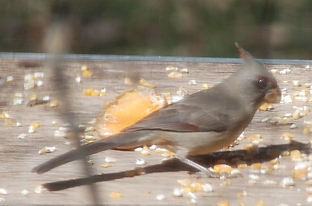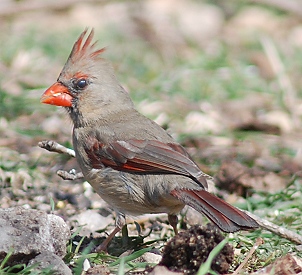Feb 05
Posted: under photography, Wildlife.
Tags: Activities, bird behavior, photography February 5th, 2009
In December 2002, I was birdwatching at the site of what would be Fox Pavilion (hadn’t been built yet.) We had a flock of cardinals that showed up every day…but that day, there was a female bird with them that wasn’t a cardinal. It was a Pyrrhuloxia, a close relative whose normal range is well […] [...more]
In December 2002, I was birdwatching at the site of what would be Fox Pavilion (hadn’t been built yet.) We had a flock of cardinals that showed up every day…but that day, there was a female bird with them that wasn’t a cardinal. It was a Pyrrhuloxia, a close relative whose normal range is well west of here.
I had only a little point and shoot camera then, and it was a heavily cloudy day, late in the afternoon, so my pictures of the female Pyrrhuloxia weren’t very good–just good enough to show that’s what it had to be. That female was somewhat melanistic, very dark indeed, noticeably darker than the female cardinals perched in the same scrubby trees.
I watched every winter, but did not see another one until today: on the feeder in the back yard. I wasn’t able to get a picture of it except through the study window–old glass, and can’t be opened so it can’t be cleaned–so it’s blurry–and handheld with my less-great lens, but here it is:

Pyrrhuloxia, female
Note that the bill is yellow, with the upper part (culmen) sharply curved, and the bird is a cool gray, with minimal red in the crest, around the eye, and in the folded wing.
Here’s a female cardinal (but this taken outside, so there’s no blurring by the old dirty glass in the window and with my best lens) as gray as they look in our yard–usually they show warmer colors–and always the red bill and more red in crest, eyes, wings, and tail.

Even though the Pyrrholoxia picture isn’t as good as I’d wish, it’s still nifty to see one back again, this time in sunlight and close enough to see details with the binoculars. I expect these “desert cardinals” (as we called them when I was a kid) to appear in our area more often as climate change makes it hotter and dryer.

Jan 13
Posted: under Wildlife.
Tags: beauty, bird behavior, observation, photography January 13th, 2009
I have only four records in eight years for the Hermit Thrush on our place, including today, all in the creek woods. In 2003, I saw one briefly near Main Ford, right in the middle of the woods, on January 27 and again on February 2…almost certainly the same individual. In late October 2007, I […] [...more]
I have only four records in eight years for the Hermit Thrush on our place, including today, all in the creek woods. In 2003, I saw one briefly near Main Ford, right in the middle of the woods, on January 27 and again on February 2…almost certainly the same individual. In late October 2007, I saw one in the south part of the creek woods, and got a (not very good) picture. We’re “supposed” to have them–we’re in their winter range–but these birds are small, shy, and easily missed among the winter sparrows. They’re quiet and secretive. I had read descriptions of the Hermit Thrush’s song but never heard it.
Until today.
Read the rest of this entry »

Jan 09
Posted: under Activities, Wildlife.
Tags: bird behavior, photography, supplemental feeding, wildlife management January 9th, 2009
We have four or five different bird populations on the place, and the first year I thought the winter-resident bunch were the dullest. After all, it’s not their breeding season, so those that have a bright breeding plumage don’t have it here. Then there are the sparrows–for two years they defeated my attempts at bird […] [...more]
We have four or five different bird populations on the place, and the first year I thought the winter-resident bunch were the dullest. After all, it’s not their breeding season, so those that have a bright breeding plumage don’t have it here. Then there are the sparrows–for two years they defeated my attempts at bird identification because I didn’t spend enough time learning which small streaky brown bird was which.
Then I spent a winter sitting out in the dry woods with binoculars day after day and discovered the beauty of winter sparrows. Now the winter birds are one of my favorite subgroups. They can’t compete with the painted buntings we get in late spring (nothing can!) but I enjoy them. And the American goldfinches, arriving all brown, with the black-and-white echelons of their wingtips on the back, gradually transform toward spring into the familiar yellow and black northerners see.
Read the rest of this entry »

Dec 31
Posted: under Wildlife.
Tags: bird behavior, observation, photography December 31st, 2008
It starts out simply, a few hours free to take a walk around and see how things are doing, though since we have not had significant rain for months, and less than half the average annual rainfall, how they’re doing is dry. Still, there’s always beauty, even muted by thirst. I head out across the […] [...more]
It starts out simply, a few hours free to take a walk around and see how things are doing, though since we have not had significant rain for months, and less than half the average annual rainfall, how they’re doing is dry. Still, there’s always beauty, even muted by thirst. I head out across the near meadow, taking a look at a thicket of young cedar elms we decided to let grow for bird habitat…and spot a nest I hadn’t noticed before. Now the tall grass has laid over, and the leaves have fallen and a beautifully constructed nest shows up, perhaps 18 -24 inches above ground in a small cedar elm that’s got branches even lower than that. It’s about 4 inches across, a deep cup, built of twigs on the outside–tiny ones–and then grass, and lined with fine grass stems.
From there I go on to the main grassland, noticing the stunted size of the bluebonnet rosettes that should be twice that size by now to give us a good show in the spring. Without more rain, it’ll be a sparse flowering. Up a diagonal mowed path to the corner of the dry woods, and then down center walk (as we call it) to the creek woods. The entrance meadow is in its winter hiatus, except for greenbriar, and I remind myself that I need to mow this down in the next week or two.
Read the rest of this entry »

Dec 24
Posted: under Wildlife.
Tags: beauty, bird behavior, observation December 24th, 2008
We have white-winged doves on our place…with the change in climate over the past 20 years, they’ve started wintering here as well (they used to migrate south in winter.) White-wings are large “dove-colored” doves–the largest native dove in the area–and except for the white flash in the wing (showing as a white stripe even on […] [...more]
We have white-winged doves on our place…with the change in climate over the past 20 years, they’ve started wintering here as well (they used to migrate south in winter.) White-wings are large “dove-colored” doves–the largest native dove in the area–and except for the white flash in the wing (showing as a white stripe even on the folded wing) they’ve always struck me as being rather plain, dull birds. They come in flocks; they’re bullies at a feeding station; they all look alike (no gender difference) and they don’t have particularly interesting songs or anything.
Silly me. Nothing in nature is really dull and plain, once we really look at it. This year the observation of white-wings has shown me something both new and colorful.
Read the rest of this entry »

Dec 16
Posted: under Wildlife.
Tags: bird behavior December 16th, 2008
In severe weather (as today), flocks of doves come in to feed. They crowd together, little heads bobbing up and down, and their level gray-taupe backs look like a moving carpet. The Inca doves are prettier; the white-wings en masse can look all too much like a carpet of feathered rats. [...more]
In severe weather (as today), flocks of doves come in to feed. They crowd together, little heads bobbing up and down, and their level gray-taupe backs look like a moving carpet. The Inca doves are prettier; the white-wings en masse can look all too much like a carpet of feathered rats.

Dec 03
Posted: under Wildlife.
Tags: bird behavior December 3rd, 2008
Doves, to some people, symbolize peace. Those people have never watched doves–especially white-winged doves–around other birds. Doves have a habit of “armpitting” other birds (and sometimes one another.) Somewhere in my files I have a photograph of a white-winged dove armpitting a cardinal who dared to land on the same branch. What’s arm-pitting? The dove […] [...more]
Doves, to some people, symbolize peace. Those people have never watched doves–especially white-winged doves–around other birds. Doves have a habit of “armpitting” other birds (and sometimes one another.) Somewhere in my files I have a photograph of a white-winged dove armpitting a cardinal who dared to land on the same branch.
What’s arm-pitting? The dove showing dominance lifts the wing on the side where the other bird is–the higher the lift, the more annoyed the dominant dove is–and reveals what would be, in a person, the armpit. I’ve seen doves stick the armpitting wing straight up, the wingtip high above the bird, but also lift it less than that.
I’ve seen Inca, ground, and mourning doves “armpit” as well as white-wings. I haven’t seen other species do it (they may–I just haven’t seen it.) Sparrows showing dominance hop towards the other bird, and peck. Mockingbirds extend both wings out a little sideways (not up) and peck. Cardinals threaten with body posture and extended beak.
Armpitting doves look silly while doing it–that one wing stuck up high, while the rest of the bird appears to be calm and composed.



